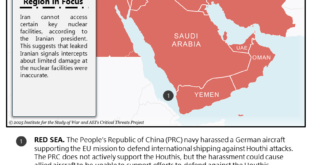In November 2020, 15 countries signed the Regional Comprehensive Economic Partnership (RCEP) amid a backdrop of deglobalisation and trade protectionism. While RCEP demonstrates the success of ASEAN’s middle-power diplomacy and promotes regional trade and economic development, it also serves China’s national interests and will make the region’s largest economy more powerful economically and politically.
China is estimated to see the largest export benefits from RCEP of US$244–248 billion by 2030, followed by Japan (US$128–135 billion) and South Korea (US$63–64 billion). This means that the increase in Chinese exports will account for nearly 50 per cent of the total export growth of all RCEP members. Although these benefits may not offset the total losses of a persisting US–China trade war, they help soften the blow to China and reduce export reliance on the United States.
RCEP also strengthens the division of labour across regional supply chains and help upgrade China’s industrial structure. Low labour costs in ASEAN countries have seen Chinese trade surpluses with ASEAN shrink since 2015, indicating an emerging supply chain relocation from China to Southeast Asia. China’s tariff-elimination commitments under RCEP further accelerates this process. China’s imports of labour-intensive goods from ASEAN countries are set to grow significantly. The inflows of these goods might increase competition with Chinese firms and generate adjustment costs that could drive them towards capital and technology-intensive manufacturing and production.
RCEP will help bring inflows of foreign investment into China. Liberalisation under RCEP includes reductions in behind-the-border barriers such as discriminatory treatment against foreign investment. The Chinese government has also promised to reduce limitations on market access and further open up a number of service and non-service sectors to multinational corporations (MNC).
Many MNCs have been wary of China’s intellectual property rights (IPR) infringements. RCEP is expected to have positive effects on IPR protection in China. RCEP’s IP chapter does have its limitations, and the majority of the provisions have already been implemented in China, but articles 11.15, 11.17 and 11.62 help the Chinese government take stricter measures. There will be stronger measures to protect digital rights management information, increase the use of non-infringing computer software and destroy pirated goods and counterfeit materials. Foreign MNCs may be more attracted to committing resources to the country, including bringing international financing and technologies. They will enhance local Chinese production, engineering and design capabilities.
China will benefit tremendously from RCEP geopolitically. First, China’s involvement in RCEP reassures neighbouring countries. Engaging actively in Asian multilateralism signals its commitment to preserving peace and promoting regional growth. Participation in RCEP demonstrates that China is willing to further open its market and be bound by common regional rules. This helps allay geopolitical suspicion among neighbours.
Second, China’s political power in the region will strengthen. RCEP reinforces economic interdependence between China and other participating countries. This will further push the region into China’s economic and political orbit, and enable Beijing to exert influence on regulations and standards within the bloc.
China seeks to conclude a trilateral free trade agreement (FTA) with South Korea and Japan to strengthen economic connectedness and build political trust. RCEP could play a catalytic role in the negotiation process, boosting the determination of China, Japan and South Korea to make a political decision. Chinese President Xi Jinping promised to speed up negotiations for the trilateral FTA in November 2020. It is expected that leaders will meet to discuss later this year.
Following the signing of RCEP, competition between the United States and China could intensify. China’s participation in RCEP further leverages its economic and political clout and impel the United States to respond in the effort to vie for geopolitical primacy in the region. The United States may be expected to maintain its trade tariffs on Chinese goods, accelerate technological decoupling with China and adopt additional strategies to advance its own industries and technologies. No matter what path the United States ultimately takes, China will continue to ramp up cooperation with countries across Asia and Europe and seek to advance its indigenous technologies.
The Biden administration has emphasised multilateralism and mending the liberal international order built by the United States. Biden has indicated some interest in re-joining the Trans-Pacific Partnership (TPP), but domestic pressures may make this unlikely even under new terms that favour the United States. Biden has also reached out to political leaders in Australia, Japan, India and South Korea, expressing his desire to deepen security alliances.
If the United States pushed the importance of trade accords like the TPP and strengthened the ‘hub-and-spokes’ network of FTAs centred around the country, Washington could better underscore its commitment to the Asia Pacific region, and provide its allies and partners with economic alternatives. There could also be room for cooperation between the United States and China, but more overt and intense competition between China and the United States is looking increasingly likely.
*About the author: Yuhan Zhang is a PhD student at the University of California, Berkeley, and a Project Director at the Berkeley APEC Study Center (BASC).
 Eurasia Press & News
Eurasia Press & News


